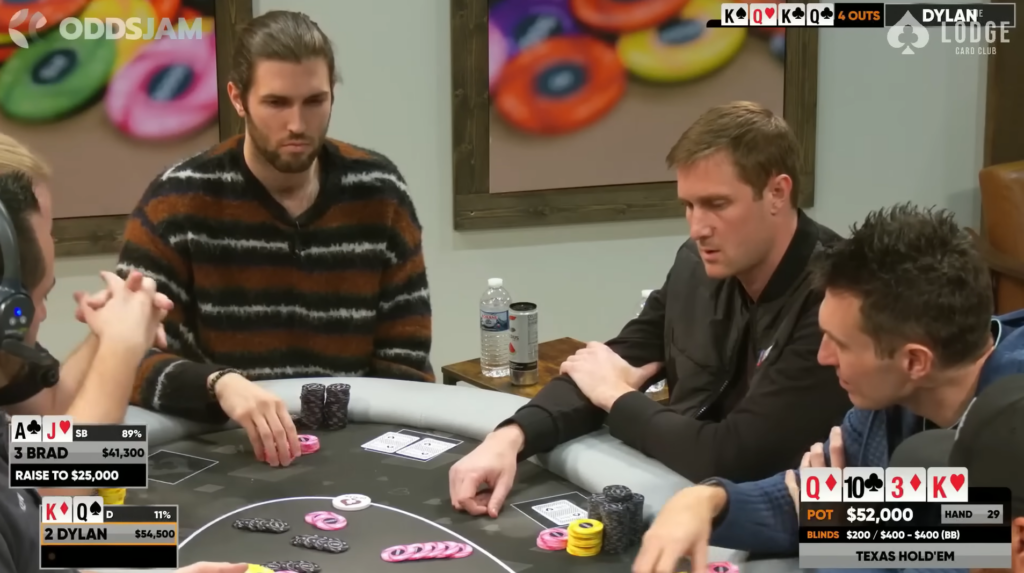The term “raise” is one of the most basic concepts in the game of poker. If you want to succeed in poker, then you must understand raising and the impact of raises in a game.
To raise in poker is to increase the amount of the active bet. Doing so forces all remaining players in a hand to either call (match the amount of your raise), or raise again. If a player doesn’t call or re-raise versus a raise, they must fold and surrender any chance to win the pot.
Let’s take a look at what it means to raise in a game of poker:
What is Raising in Poker?
Raise is one of five decisions a player can make when the action comes around to them in a poker game. Those four decisions look like this:
Depending on the situation, some of these options might not be available when the action is on you.
Raising becomes an option when a player in front of you bets. When it comes your turn, you must at least match the amount of that bet (aka call) to stay in the hand.
You can also increase the amount of the active bet by raising. All players that act after you must then either match the amount of your raise, or fold.
Examples of Raising in Poker
Let’s take a look at an example hand beginning to end, and see how raising (along with the other three basic actions) apply to a poker hand.
Raising Preflop
Each hand of poker begins with the preflop betting round (assuming you’re playing Texas Hold’em, Pot-Limit Omaha, or one of the many other games that use community cards).
The small blind and big blind post mandatory bets before the hand begins. The first player to act then gets the opportunity to either call the amount of the big blind, raise (make the active bet a higher amount), or fold.
Once that player acts, all other players can either call, raise or fold.
For instance, let’s say you’re sitting in a $2/$5 No-Limit Hold’em game at the Lodge. The $2/$5 notation means the player in the small blind position posts a $2 mandatory bet before each hand. The big blind position must post $5.
Each player is then dealt two hole cards, and the preflop action begins with the player to the direct left of the big blind. That player can either call the big blind amount (putting $5 into the pot), raise (putting at least $10 in the pot), or fold.
Let’s say the first player calls. The next player can then call, raise or fold.
If the first-to-act player were to raise to $10, the next player can still call, raise, or fold. The first raise in the preflop round (aka raising the amount of the big blind) is known as an open raise. You’ll sometimes see “raise” and “bet” used interchangeably when referring to an open raise.
In any hand, a player must either call the amount of the active bet, or raise, to stay in the hand.
Suppose the first-to-act player open raises to $10 preflop. When the action gets to you, you can then re-raise. Say you re-raise to $30
All players acting after you must now match the amount of your raise ($30 total), re-raise again, or fold.
In the preflop betting round, the first re-raise that happens is known as a “3-bet” (the big blind is the first bet, the raise to $10 is the second bet, and the re-raise to $30 is the third bet/3-bet in the above example).
A re-raise against a 3-bet is called a “4-bet,” a re-raise against a 4-bet is called a “5-bet,” and so on.

Raising Postflop
Once the preflop betting round ends, the hand goes to the flop. The amount of the active bet resets to zero.
If the amount of the active bet is zero when the action gets to you, you can check. Checking means not putting any money into the pot, and passing the action to the next player. You can also raise.
Let’s say three players are in a hand on the flop with $30 in the pot. The first-to-act player checks, and the second player bets $20. The $20 bet represents a raise, although the terms bet/raise can be used interchangeably when referring to the first bet in a posflop betting round.
The third player can then either call (match the $20) raise to a larger amount (must be at least $40), or fold. Suppose the third player calls.
If the first player were to raise to $80, the second player must either call the $80, re-raise or fold. Note that since the second player already has $20 committed to the pot, calling the raise costs $60 more.
If a player bets or raises, and all players behind them fold, the hand ends, and the player that made the last bet or raise wins the pot.
In the last betting round (known as the river), if a player calls a bet/raise, and no other players remain in the hand, the players still in the hand go to showdown. The player with the best hand according to poker hand rankings wins the pot.
At any time in a poker game, if a player raises and puts all of their remaining chips in the pot, other players can choose to call or fold. Once a player commits all of their chips to the pot, they can no longer bet or raise at any time during the rest of the hand.



